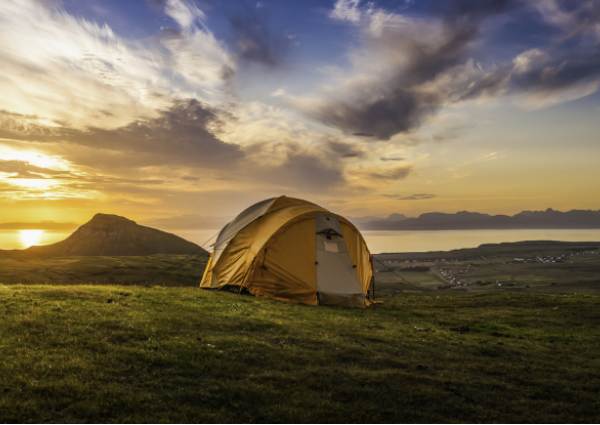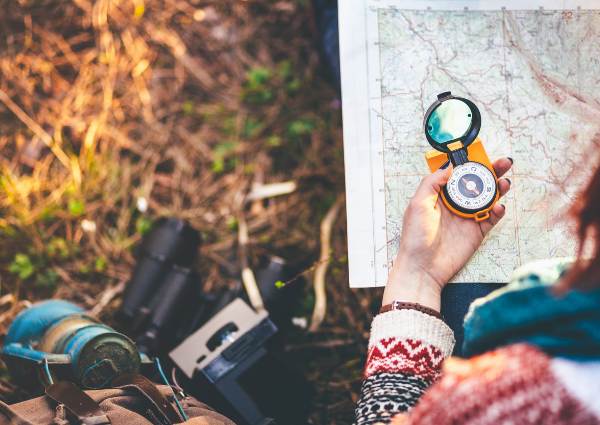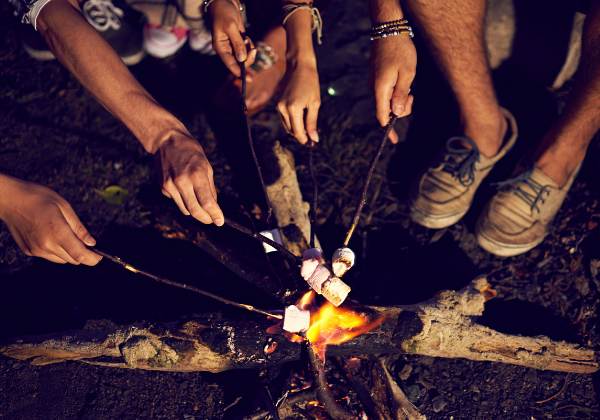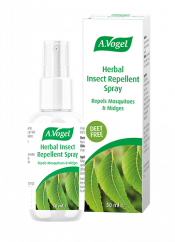Your survival guide to camping
Whether you’re a fan of the great outdoors or a curious amateur, camping can be a challenging and demanding experience, requiring a great deal of planning, patience and fortitude. Arguably, camping is definitely not for everyone, especially if you’re fond of the simple pleasures in life, like a Wi-Fi connection and indoor plumbing. However, the benefits and rewards ultimately outweigh the difficulties, and many sceptics have been converted to camping over the years.
Deciding what to take and what not to take is often half the struggle, particularly since space is a finite resource. This is why we have decided to point you in the right direction and give you a few extra tips that should help to make your camping experience more enjoyable and relaxing.
How to prepare

Environment: Where will you be camping? This is often the factor that will dictate your entire camping trip. If you’re deciding to pitch your tent in the highlands of Scotland, it is likely that you will require an entirely different set of luggage from someone backpacking across Thailand. Where you pitch your tent can also determine what amenities are nearby – if you’re camping in a family-friendly campsite then you are probably going to be close to rudimentary conveniences such as running water, indoor showering facilities and even an onsite café. Step further into wilds though and you’re dealing with the idea that you won’t have access to these basic luxuries. Instead, you will be entirely reliant on what you bring with you and may need to consider your travel gear more seriously.
Weather: It might be the peak of summer in the British Isles but a sudden downpour will rarely surprise any native of the UK. Whether or not the weatherman has promised wall to wall sunshine, even the most optimistic camper will know better than to rely on the forecast and will instead prepare for the constant possibility of rain, wind and possibly thunder. If you’re planning on venturing abroad though, you might need to alter your usual baggage considerably. It’s not impossible, but an abrupt rainstorm in the middle of Arizona is far more unlikely so packing extra sunscreen might be more worthwhile than investing in a rain fly.
Insects and wildlife: Great Britain does not exactly boast an exotic or deadly array of insects and wildlife. The majestic red deer might look impressive but unless you’re stupid enough to pick a fight with it, you are likely to be left alone. Instead you should probably brace yourself – midges and houseflies will definitely be coming. However, the most surprising animal you’re likely to bump into is a random and bemused cow on the way to the bathroom at three o’clock in the morning. Further afield from the British Isles you are presented with a real problem. The wildlife in countries like the USA, Canada and most parts of Asia are definitely not so passive or docile and will likely bite back – hard. Don’t just Google the most idyllic camping spots in the USA and make a judgement based off a five star picture. The best thing you can do is research –when is the peak mosquito season in Texas? How do you avoid bears in Canada? Is everything really out to kill you in Australia? Find out as much as possible and come to your own decision about where you realistically feel confident going.
Allergies: If you suffer from allergies, you definitely shouldn’t let it hold you back. Nevertheless, you should be aware of what triggers a reaction and how you should go about minimalizing your suffering. Camping in the middle of a forest during peak pollen season is probably not a good idea if you’re prone to bouts of hayfever – instead either wait until early autumn or pick a spot closer to the beach, where the pollen count is not so high. If you’ve ever came out in hives after being bitten by an insect then research when and where that particular bug is most active and plan accordingly. Preparation is key and if you plan carefully, there is no reason why you should not enjoy an allergy-free camping trip
Tent: The most essential piece of luggage you are likely to pack is your tent. There are many different varieties and accessories but primarily, your camping environment should influence the type of tent you decide to take with you. For example, if you’re camping in Wales during October, then a sturdy, durable model is more advisable, the more waterproof, the better. Bringing along a two-man tent with no room to store your damp clothing is probably a bad idea and it might be worth spending a little extra cash on a larger tent with separate sleeping quarters and a communal space. On the other hand, if you’re fortunate enough to be braving the great outdoors in Africa or some of the southern states in the US, then maybe a cotton tent would be more advisable. These tents allow for a better circulation of air than their polyester or nylon counterparts, and you are less likely to experience a build of moisture or condensation
Food: Unless you’re bringing Bear Grylls along with you on your expedition, the chances are you aren’t that familiar with how to forage or hunt for food in the wild. This means that you will have to rely on what you bring with you for nourishment and, since time and nature are working against you, it can be tricky to know what to bring. Eating pot noodles or surviving off protein bars for a week isn’t all the appealing so you are going to have to consider how you store your food and what bits and pieces you can bring with you to make things easier. If you’re able to build a campfire and incorporate that element into your cooking, then that’s brilliant but if you’re not so comfortable playing with fire, then maybe investing in a portable barbeque or a gas stove might be more up your avenue. Try to prepare as many pre-cooked meals as possible before you leave. Salads can be kept cold using a cooler, which might see you through the first couple of days. Look into different cooking ideas – there are plenty of websites that have some great recipes to use while you are camping, like walking tacos or banana boats
The essentials

First aid kit: The odds are you might be nursing a growing migraine from the moment you try and pitch your tent, but over the course of your camping trip, it’s possible you might develop more pressing injuries. Depending on where you’re going, your first aid kit might just be a Tupperware box filled with plasters, gauze, Echinacea cream, hayfever tablets and aspirins. This should be adequate and will cover most basic accidents but if you’re venturing somewhere more exotic, you might need to expand your horizons. If you plan on lighting a campfire, it might an idea to include a burn kit or, if insect bites are a concern, try to pack a small bottle of aloe vera. A.Vogel’s Atrogel might also be worth your consideration as it can be used to soothe bruising, relieve joint pain and muscle stiffness.
Survival kit: If you’re camping in the UK, surviving the British weather might seem like enough of a challenge. However, no matter where you are, a survival kit can be a useful and extremely beneficial addition to your luggage. Something as simple as packing a spare set of torch batteries, or including a sharp camping knife can make a real difference in a survival situation. A water filter can also be a vital piece of equipment, particularly if you can no longer stock your cooler and are having to make do with stagnant, lukewarm water instead.
Appropriate clothing: Clothes maketh the man, or in the case, at least broadcast their levels of common sense. If you’re camping somewhere abroad, like Australia or Arizona, you might be tempted to venture out and about in shorts and tee-shirts, but this would be a disastrous and potentially life-threatening move on your part. Exposing your delicate skin to UV radiation, bloodsucking insects and low humidity is never a good idea. Instead, try to wear loose, light coloured clothing and remember to pack a wide-brimmed hat and a pair of sunglasses to shield your eyes from any potential damage. On the flip side of this advice, if you happen to be setting up camp in Scotland, be prepared to amend your wardrobe considerably. Wellie-boots, anoraks and waterproof trousers might not be the most aesthetically pleasing look to model, but neither is wandering around looking like a drowned rat, soaked to your skin in sandals and three-quarter lengths.
Appropriate bedding: You might go camping and expect an everyday sleeping bag should do the trick but very rarely is this the case. If you’re camping in a country prone to wet, windy weather conditions, it might be worthwhile investing in a waterproof sleeping bag. Your tent, hopefully, will not get flooded but a build-up of condensation can create a muggy, moist environment, making your usual bedding unpleasantly soggy and utterly unappealing to sleep in. Using a waterproof sleeping bag should at least give you a dry place to rest your head and provide you with enough insulation to keep you warm and snug. In hotter climates, it might be worth choosing a summer sleeping bag made of lighter material, that should enable your body to breathe while you sleep.
Sunscreen: Sunscreen is an essential, especially if you are heading somewhere warm and sunny. The damage that UV radiation can do to your skin is no laughing matter, not to mention the risks of heatstroke and dehydration. Keeping yourself protected from sunburn should be a top priority but often it can be difficult to choose a suitable sunscreen, particularly if you suffer from dry or sensitive skin. If this is a pressing concern, it might be worth considering a natural alternative that does not contain the abrasive toxins found in conventional sunscreen. Your Health Food Store stocks a range of organic, natural sunscreens that are suitable for sensitive skin types and can protect your skin without causing any irritation.
Plenty of water: Not to burst your bubble, but water should be your number one priority, particularly if you’re camping somewhere hot. No matter where you go, dehydration is still going to be a major issue to consider. If you’re camping at a festival or simply going away on holiday, it might be tempting to stock up on fizzy drinks, mixers and alcohol without really considering how much water you need to consume. On average, you should be drinking around 8-10 glasses of the stuff a day unless you want to risk contracting a kidney infection, heatstroke or constipation – and these are just a few of the symptoms we can name. Pack plenty of bottled water and try to keep it cold and filtered. Do not leave a bottle lying open overnight or you might find that a passing mosquito or curious midge has decided to use it as their personal swimming pool. Instead keep it stored in a cooler or if that’s not possible, somewhere shaded like a canopy. Drink a little but make sure you drink often, especially if you’ve also packed a bottle of wine or a couple of cans of beer on the side!
Ventilation: Rain or shine, keeping your tent ventilated can be challenging. If it’s raining outside, the last thing you’re going to want to do is keep the tent open and exposed to the elements. Nevertheless, you should try to allow for a steady flow of fresh air to prevent a build-up of condensation. Keeping the rain fly slightly open should produce a steady circulation of air without compromising the integrity of the tent. If you’re camping in conditions of extreme heat, you could try leaving the tent open throughout the day to prevent it from becoming too hot and stuffy.
Repelling pests

Use neem insect spray: Insects are bound to be a nuisance wherever you’re going. Most creepy crawlies can thrive in either damp or dry weather and can seem magnetically attracted to your skin, often trying to snatch a bite of your blood. This can be a real problem as some insects, like mosquitoes, carry dangerous diseases such malaria, yellow fever or zika. Keeping them at bay can be difficult, so investing in an effective insect repellent is usually necessary. Unfortunately, most conventional bug sprays rely on powerful but toxic chemicals, often irritating your skin or even triggering an allergic reaction. A.Vogel’s Neem Insect Repellent, however, is an entirely natural and organic product that does not use any abrasive toxins and instead is made using plant extracts. It can work just as efficiently as conventional sprays but can also soothe your skin as neem is renowned for easing itchiness and relieving irritation. This product can be used on children but should not be used by breastfeeding mothers or pregnant women
Use a mosquito net: If you’re visiting somewhere that has a rampant population of mosquitoes, a mosquito net will be a must-have necessity. Mosquitoes only require six seconds to transfer their diseases into our bloodstream and most species are generally more active during the night, making you extremely susceptible to being bitten while you are asleep. Using a mosquito net should enable you to sleep peacefully and safely, your skin well-guarded from the parasitical insects. If you want to learn more about other preventative measures that you can take against mosquitoes, please read our blog, ‘Top 10 tips to prevent mosquitoes’
Keep away from stagnant water: Insects love splashing about in water almost as much as humans do, many of them even choosing to lay their eggs in stagnant pools or the shallows of ponds. This can mean that they will be instinctively drawn to your campsite if you leave buckets of water out overnight or choose a spot close to a lake or a river. If you want to try and avoid these critters, it might be best to stay further inland and avoid leaving liquids lying around your campsite.
Treat your clothes: If you feel that you want to take extra precautions against bug bites, it might be a good idea to try treating your clothes with insect repellent spray. You can do this by soaking your clothes in a solution of insect repellent and water overnight, drying them as normal the next day, or you could try spraying your clothes whilst they are drying outside on the clothes line. This should hopefully work alongside any other protective measures you have taken and send a clear message to any potential pests to stay well away
Don’t leave food out: If you’re camping out in the wilds you should show some respect towards nature and not leave your empty crisp packets, paper plates and tin cans here, there and everywhere. Not only is it extremely damaging to the environment, it can also attract animals and insects to your campsite. Flies and wasps love nothing more than a half-empty can of coco cola and vermin like mice and rats would probably be more than happy to finish off your bacon sandwich for you. Instead of attracting unwanted attention, do the adult thing and either bin your leftovers or at least wrap them up in a black bin liner
Don’t wear strong fragrances: If you’re camping and concerned about your personal hygiene, you might be more likely to use deodorants and body sprays in order to mask your body odour. This might reassure your self-esteem but it can also be a green light for certain insects to take an unwanted interest in your skin. Bugs and beasties are attracted towards strong aromas, and you will have just singled yourself out as the choicest meal available. Instead, it might be worth your while considering an unscented deodorant like A.Vogel’s Salt of the Earth Deodorant Spray, which contains no fragrances or preservatives and works to obstruct the biological process leading to body odour
Peak times: If you’re camping somewhere very warm, it is probably a good idea to be familiar with peak times. Peak times are when the sun is at its hottest, normally between the hours of 11 am and 3pm. During this time you should try to stick to the shade and avoid doing any strenuous activities that might dehydrate you and place you at risk of contracting sunburn. If you want to go for a hike, try going around twilight in the evening or sunrise in the morning. It might also be worth considering the insect population where you are camping – for example, mosquitoes tend to be active during the night and the very early morning, so you should take extra care to protect yourself against being bitten during these times.
Things to do

Outdoor activities: If the sun is shining, there is no reason why you shouldn’t be out enjoying the weather - providing you’re suitably protected, of course. You could try going on a hike to get a better glimpse of the scenery, or taking your children on a scavenger hunt in the forest to teach them more about the environment and nature. Playing a game of football or tennis is also a good way of exercising and socialising with other campers. Just make sure that you respect your surroundings and try to plan your activities carefully, especially if you are camping in an area with a high insect population.
Outdoor crafts: There are plenty of arts and crafts activities that you can try, incorporating aspects of nature as part of your display. If you enjoy photography, you could try exploring your surroundings for interest scenes or you could try to capture images of the local wildlife. Children can also join in on the fun by collecting leaves and making animal pictures out of them, or decorating rocks with felt tip pens and pine needles to create hedgehogs and rabbits.
Group storytelling: Group storytelling is an excellent activity if you’re gathered around a campfire or spending the evening nestled inside your tent. It gives you a chance to showcase your creativity and can even provide a lot of laughter if you start by telling one fragment of a tale and then leave it open to the other campers to add their own ideas. You could also try playing a memory game like ‘in my suitcase I have’ in order to keep your mind stimulated and give an opportunity for everyone to contribute.
Star gazing: If you’re lucky enough to be camping under a clear sky, you could try star gazing as a relaxing way of passing the time. Try to see what constellations you can spy with your naked eye or bring along a portable telescope for a better glimpse at the heavens. Not only does it provide you with stunning images of the stars, it can also give you a better appreciation of the planets and an insight into the wonders of the universe.
Indoor activities: When the weather starts working against you and preventing you from having fun outside, you can always try a few indoor activities to relieve the rainy day blues. You could try packing a few board games or a pack of cards so that you can pass the time away playing games with your friends and fellow campers. You could even try your hand a few craft activities, like painting or cross-stitching so that you can keep the creative juices flowing, or simply keep the kids amused until the downpour stops.





 Looking for our products in a store near you?
Looking for our products in a store near you?

